- Home
- Glazing Watercolor
Glazing with Watercolor: Something Every Watercolor Artist Needs to Know
Glazing with watercolor is an essential technique of using watercolor.
Whether you're a beginner or an experienced artist, mastering the art of glazing opens up a world of creative possibilities.
We will walk you through the essentials of glazing with step-by-step instructions and tips on how to use glazes.
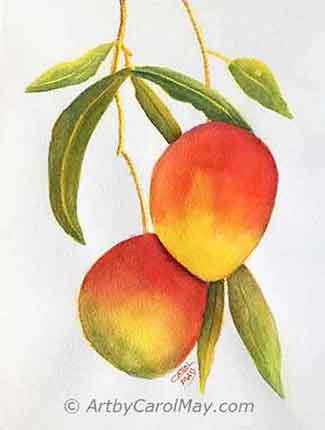 Let's glaze luscious mangoes.
Let's glaze luscious mangoes.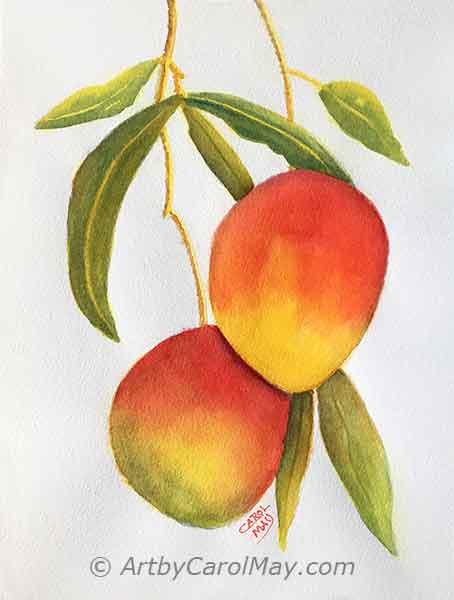 Let's glaze luscious mangoes.
Let's glaze luscious mangoes.What Is Glazing?
Watercolor glazing is painting a layer of transparent color over a dry layer of paint.
The colors mix on the painting instead of on the palette.
The viewer sees both layers of paint and their eye visually mixes the color. The colors are more luminous than when they are mixed on the palette.
Just starting watercolor? You may check out the tips on beginners watercolor.
Is Glazing the Same as a Wash?
Technically - Yes and No. Watercolor glazing it is often called laying down a wash.
When we paint diluted watercolor on an area of the painting - that's called a wash.
Glazing with watercolor is painting an additional wash over a dry, previously painted wash.
What Colors Do We Use for Glazing Watercolor?
Single pigment, transparent, staining colors produce the best results. Why are they the best?
- Single pigment colors glazed together create beautiful clean colors. Glazing mixed pigment colors has a good chance of making mud!
- Transparent colors let the underneath color show through.
- Staining colors are less likely to lift when we glaze the next layer.
Some staining, transparent, single pigment colors to look for:
- Yellow: Lemon Yellows PY175, PY2, Medium Yellow PY97, Deep Yellow PY65
- Red: Scarlet Lake PR188, Quinacridone Red PR209, Permanent Rose PV19
- Violet: Dioxazine Purple PV23, Quinacridone Magenta PV42
- Blue: Phthalo Blues PB15.1, PB15.3
- Green: Phthalo Greens PG7, PG36
Most manufactures put the information on the paint label. Otherwise look on their website.
Do We Use Semi-transparent or Opaque Colors?
Yes, these colors certainly may be used for glazing with variable results.
Opaque and semi-opaque colors, the Cadmium colors, Cerulean Blue, Naples and Yellow Ochre may be used for the first wash. In subsequent washes, they will block the view of the underlying color.
Semi-transparent colors such as Cobalt Blue, Burnt Sienna, Viridian, Pyrrole Red or Scarlet, Quinacridone Gold and New Gamboge are certainly usable for glazing. They will partially block the view of the first wash.
Granulating colors like Ultramarine Blue or Violet, Rose Madder, Manganese Blue, Terre Verte and Raw Sienna produce interesting results. The underlying color is blocked by the granulation, but is visible between the granulated particles.
Materials for Glazing with Watercolor
One hundred percent cotton watercolor paper handles multiple washes the best.
Use a soft, large watercolor brush. A large brush will lay the color on with the least amount of stroking. Multiple small brush strokes increase the chance of picking up the underlying colors.
This painting was done with Winsor & Newton professional tube watercolors.
- Lemon Yellow, New Gamboge, Raw Sienna, Ultramarine Blue and Winsor Red
Whatever brand you use make sure the colors are transparent or at least semi-transparent. Glazing won't work well with opaque colors.
Winsor & Newton marks their paint tubes with a white square for transparent paints and a black square for opaque colors.
Glazing with Watercolor Step-by-Step
Ready to start glazing? This comprehensive guide will walk you through the initial washes to the final touches.
First, lightly sketch the mangoes on the paper with a pencil.
Initial Washes
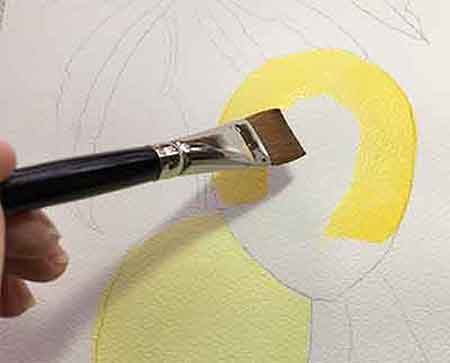 Initial Washes
Initial Washes- Use a soft flat watercolor brush to wet the area you will be working on.
This is important for glazing with watercolor. Then the paint can be applied without forming hard edges.
Paint the lower mango with the cool yellow, Lemon Yellow.
This mango is behind and farther back than the top mango. The cool yellow make it recede.
Paint the top mango with the warm yellow, New Gamboge.
Let these colors dry thoroughly. Depending on the temperature and humidity, watercolor may take up to an hour or two to thoroughly dry.
Second Wash: Layering Red
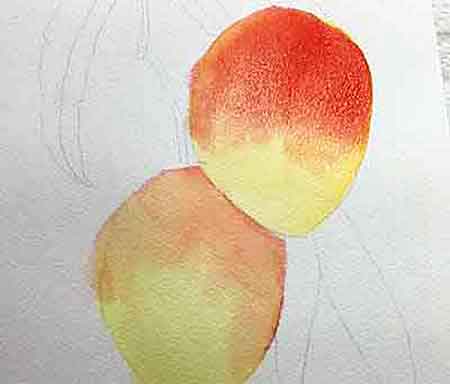 Second Wash = Glazing
Second Wash = Glazing- When you are glazing with watercolor the initial wash must be completely dry. Then when you apply more colors, they will not mix together.
Clean your brush of any paint from the previous layer before adding a new layer of paint.
Make a wash of the Winsor Red and water. Winsor Red is a transparent color. If you don't have Winsor Red, use Permanent Rose which is a transparent color.
The Cadmium colors are opaque and do not work well for glazing.
Let each layer dry thoroughly before you add another glaze layer.
Adding a Blue Glaze
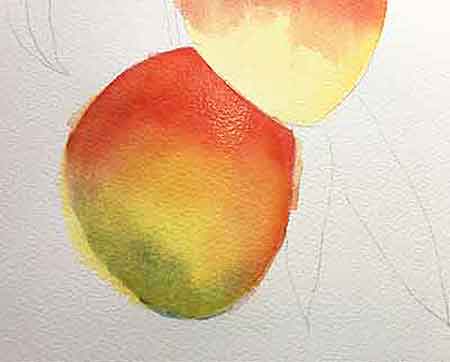 The glaze of blue makes green.
The glaze of blue makes green.- When the underlying colors are thoroughly dry, add the next glaze.
This time we use Ultramarine Blue.
Ultramarine Blue has the characteristic of granulating when it is applied.
The granulation portrays the color variation and texture of the mango.
Ultramarine works for this application instead of other blues because of its granulating characteristic.
Yikes! I got sloppy and painted outside of my sketching lines. What can I do?
Creating Shadows and Form
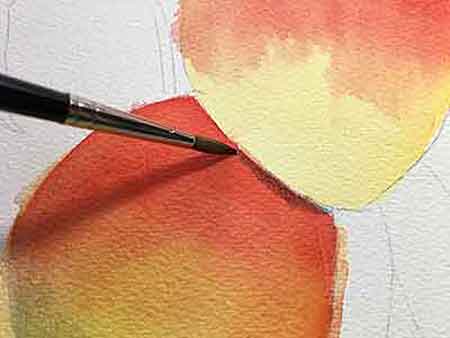 Shadow the overlapping mango.
Shadow the overlapping mango.- This time, do not pre-wet the area.
Use the same blue where the top mango overlaps the bottom mango.
Apply a line of blue with a round brush.
Immediately come back with some clear water to softly feather in the bottom edge of the shadow.
Using the same technique, softly apply some blue around the outside edge of the mango.
This makes the edge of the mango turn away from the viewer to give it a rounded appearance.
Continue Glazing for Color Adjustments
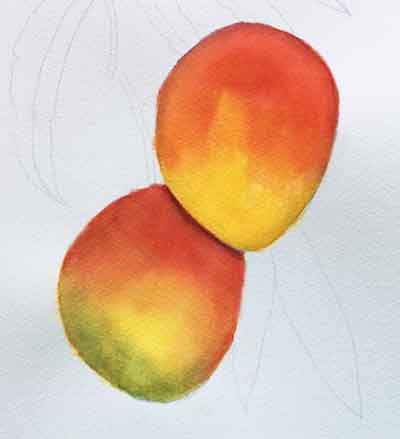 Finish glazing the mangoes.
Finish glazing the mangoes.- Glazing with watercolor takes multiple layers.
This is how to use watercolor.
It took more than one glaze of the red to achieve the mango color.
Each glaze intensifies the color and darkens the value.
The viewer's eye sees down thru the multiple transparent layers.
Add more glazes of yellow to intensify the color.
Continue to use the warm yellow on the top mango.
The cool yellow on the bottom mango will set it behind the top mango. Learn more about color.
Continue glazing until you are satisfied with the intensity and value of the colors.
Paint the Leaves
Glazing isn't just for the main subject. It can also add depth and interest to the background elements.
In this section, we'll focus on painting leaves and stems to complement the main subject.
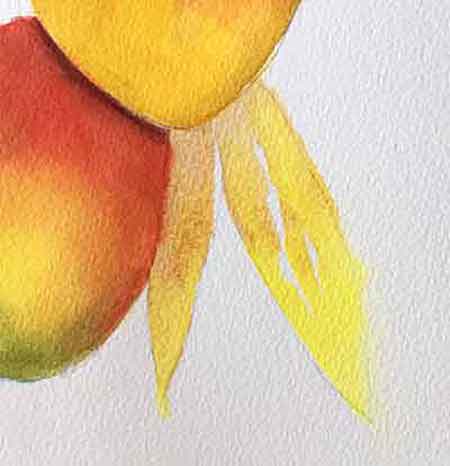 Do the lower leaves first.
Do the lower leaves first.- Let's do the leaves behind the fruit first.
Paint the leaves with yellow.
We used Raw Sienna close to the fruit for the shadow area and Lemon Yellow farther away from the fruit.
Raw Sienna made an earthy colored leaf. If you want a cleaner green use Lemon Yellow all the way.
When we are painting watercolor, we use the paper for white. Some white on the leaves adds interest.
More ways to preserve the white paper.
After the yellow is dry glaze on some blue to make the leaves green.
If you used Lemon Yellow for the entire leaf, then darken the shadow area with extra glaze of blue.
Paint the Top Leaves Yellow
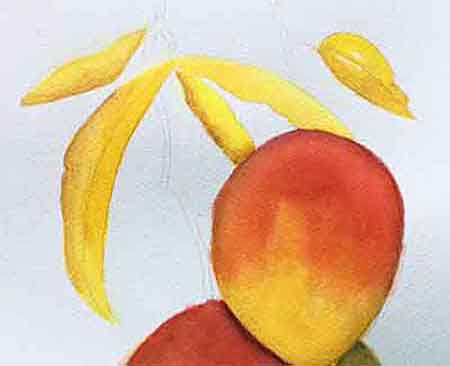
Paint the leaves with yellow and let it dry.
Use your choice of yellow. Raw Sienna on some of the edges created a more earthy color.
Start Glazing on Blue
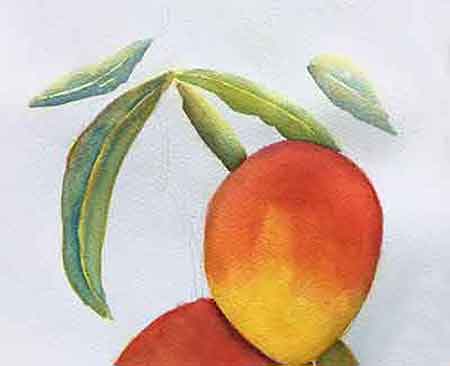
Start glazing on blue to create green leaves.
Paint around the center veins or pull it out later with a damp brush.
Painting Wet into Wet
There is a freedom when one color is painted directly into another moist color.
It is pure joy watching the beauty of the way the moist colors flow and blend together.
Paint the Stems with Gamboge
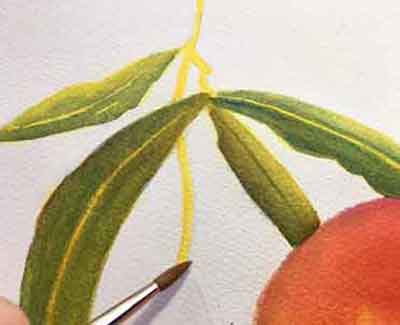
While the yellow is still moist, add a bit of Raw Sienna on the shadow side of the stems.
Paint a Shadow on One Side
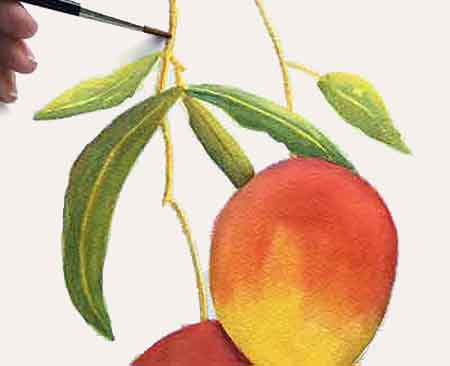
Paint blue in some areas on the shadow side of the stems. The colors blend together.
Troubleshooting and Tips
Pro Tip: When the painted area is dry, it will not have any shine. Touch it with the back of finger and it will not feel cool. Using a hair dryer will speed up the dry time.
Pro Tip: How do we correct a watercolor mistake? We may paint outside of the leaf area.
While the paint is still wet, quickly blot it up with a tissue or a paper towel.
If the paint is already dry, use a wet brush to dampen it and scrub it a bit with the damp brush. Then lift off the color with your tissue. Repeat it, as necessary.
What Are Some Ways to Use Glazes?
- Deepen a value: Apply successive washes of the same color to deepen and intensify the color.
- Create a new color: Glazing blue over yellow would create a luminous green.
- Subdue a color: Painting violet on a pink flower petal would subdue and cool the pink.
- Create distance: A soft blue on the background of a landscape would move it into the distance.
- Unify a painting: Glazing an entire painting with yellow to warm it or blue to cool the painting.
The only limitation on using glazes is the imagination of the artist. You can probably think of more.
Have Fun Painting Your Mangoes!
Glazing with watercolor opens up endless possibilities in our paintings. The beauty of watercolor is its transparency and glazing amplifies it.
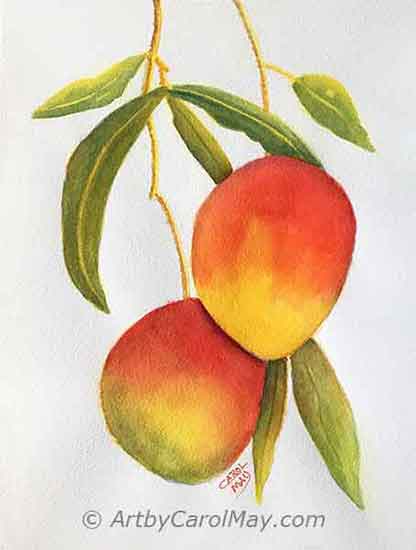 Now it's your turn!
Now it's your turn!Keep practicing and check out more pages for instruction and inspiration.







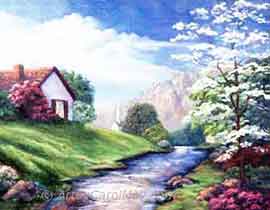 Are you new and want to learn how to paint art? On this page, you’ll find ideas of what to paint, the supplies we really need, the fundamentals of good art (values, color, composition), and beginner-f…
Are you new and want to learn how to paint art? On this page, you’ll find ideas of what to paint, the supplies we really need, the fundamentals of good art (values, color, composition), and beginner-f…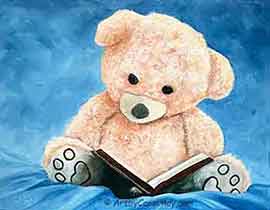 Are you eager to learn how to oil paint? What are the essential supplies for oil painting? What do we need for clean-up and how long do oil paintings take to dry? Learn the rules of oil painting and t…
Are you eager to learn how to oil paint? What are the essential supplies for oil painting? What do we need for clean-up and how long do oil paintings take to dry? Learn the rules of oil painting and t…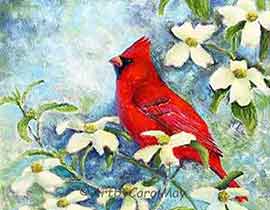 How do we create a focal point in art? Where do we put the focal point? How do we find the focus of an artwork? Should all paintings have a center of interest or can they have more than one? Learn fro…
How do we create a focal point in art? Where do we put the focal point? How do we find the focus of an artwork? Should all paintings have a center of interest or can they have more than one? Learn fro…